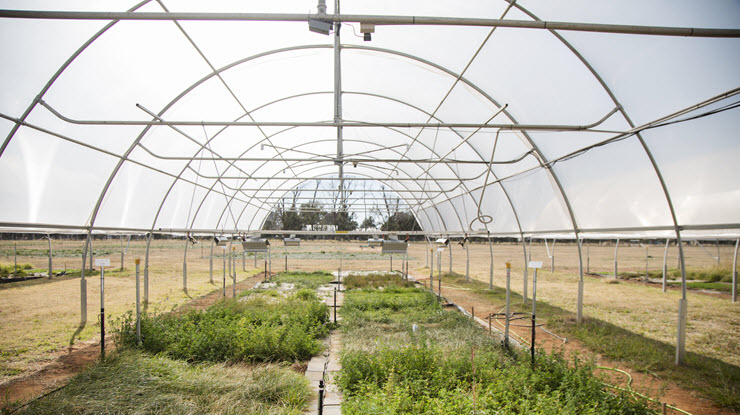
Caption: Each polytunnel used for the PACE project houses sub-plots planted with fescue – either individual species or mixtures – to enable researchers to assess pasture performance under a predicted future climate scenario.
Feedbase future-proofing
“It’s like putting pasture plants in a time machine and taking them to climate conditions that are predicted for the future,” Professor Sally Power said of the Pastures and Climate Extremes (PACE) project she leads.
“We’re looking at what the climate is likely to be later this century, which in southern and eastern Australia is generally warmer, with higher CO2 concentrations, more heat waves and reduced spring and winter rainfall, and seeing how that affects pasture growth.”
Keeping up the pace
Based at the University of Western Sydney’s Hawkesbury Campus, the PACE project is funded by MLA Donor Company and Dairy Australia. It started at the end of 2016 with the construction of six large polytunnels to enable climate control. Infrared heat lamps are used to increase air temperature and rainfall is added in line with current and future rainfall scenarios.
The first phase of the project will run for three years.
Hot and dry
Not all experimental plots are being exposed to heat stress, but all are being ‘droughted’, with watering applied at a rate that reflects a 60% reduction in winter and spring rainfall. This is roughly equivalent to the climate experienced in many parts of NSW in 2018, so the scenario is entirely realistic and will provide useful, real-world information.
Research plots have been planted with a range of widely grown pasture grasses and legumes to enable their response to drought and heat stress to be tested.
“By measuring a suite of physiological, morphological and biochemical traits, we hope to provide new insight into the mechanisms that determine sensitivity and resilience in climate extremes. This will help us identify traits that enable plants to cope with the more extreme conditions that are predicted to occur, more often and for longer,” Sally said.
“Those characteristics will in turn help us identify other species and cultivars with those traits, so ultimately producers can choose ones more likely to perform well in future, more extreme climates.”
Early indications
“Our two main climate treatments – warming (+3°C) and (winter/spring) drought – were initiated in 2018 and we’re now seeing some interesting treatment effects,” Sally said.
Early observations included:
- fescue productivity in late spring was particularly reduced in drought conditions, with an 80% decrease compared to control plots recorded in November 2018
- biserrula was the most strongly affected legume in spring 2018, with a 50% reduction in productivity in drought plots compared to a decrease of 33% for lucerne
- tropical C4 grasses maintained higher yields in drought conditions than their temperate counterparts, although yield reductions of up to 50% were still observed at the end of spring.
Recovery after drought is an important aspect of a species’ resilience, so will be carefully monitored by the researchers.
“Big species differences in mortality at the end of the drought (e.g. 80% dead fescue, compared to 0% dead kangaroo grass) will undoubtedly influence recovery trajectories, and this is one of the things we are looking at during autumn,” Sally said.
“We need to know how our treatments affect pasture persistence, how much of a legacy winter and spring drought has for summer growth, and what plant and microbial traits are associated with faster and/or more complete sward recovery, both in terms of productivity and nutrition.”
Glasshouse trials
Along with the polytunnel trial plots, glasshouse experiments are being used to assess specific aspects of climate resilience.
“Importantly, glasshouse experiments will also allow us to evaluate the impact of elevated CO2 concentrations (a key component of future climate predictions) on species’ performance, and interactions between plants and their symbiotic microbes,” Sally said.
“Our preliminary findings confirm that grasses grown with legumes are much more productive than grasses grown on their own and, in particular, that they benefit from elevated CO2 when grown in combination with legumes, but not when grown alone.”
The researchers believe that this grass biomass increase was caused by the grasses accessing additional nitrogen fixed by the legume, which grew more in the presence of elevated CO2, even though the grasses themselves did not appear to benefit directly from increased CO2.
This increase in legume ‘facilitation’ of grass growth is an interesting mechanism that may contribute to enhanced performance of mixed pastures in future increased concentrations of atmospheric CO2.



